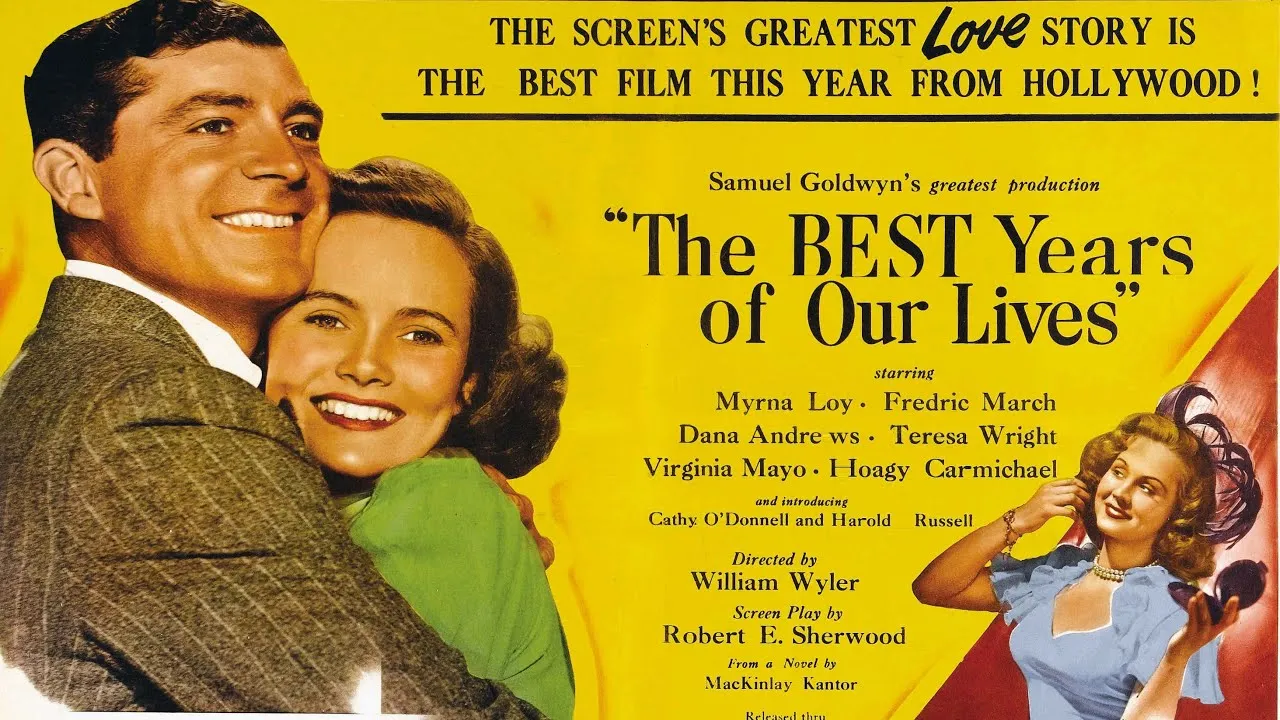
The Best Years of Our Lives is a 1946 American drama film directed by William Wyler and starring Myrna Loy, Fredric March, Dana Andrews, Teresa Wright, Virginia Mayo, and Harold Russell.
The film was a massive commercial success, earning an estimated $10 million at the U.S. and Canadian box office during its initial theatrical run, making it the highest-grossing film of 1946 and the highest-grossing film of the 1940s decade. It was the first major Hollywood production to deal with the problems faced by veterans returning from World War II.
Plot
The movie follows the lives of three United States servicemen, Al Stephenson, Fred Derry, and Homer Parrish, as they return home from World War II and try to adjust to civilian life. The three men come from different services with different ranks that do not correspond with their civilian social class backgrounds.
The film explores the challenges faced by the veterans as they try to reintegrate into society, including post-traumatic stress disorder, physical disabilities, and financial difficulties. all three men become fast friends, and Fred Derry finds himself falling in love with Al's daughter, Peggy, as his marriage falls apart. In the end, all three men find ways to move forward with their lives.
Trailer
Cast
The full cast for the film "The Best Years of Our Lives" (1946) is as follows:
Main Cast:
- Fredric March as Al Stephenson
- Myrna Loy as Milly Stephenson
- Dana Andrews as Fred Derry
- Teresa Wright as Wilma Cameron
- Virginia Mayo as Marie Derry
- Harold Russell as Homer Parrish
Supporting Cast:
- Cathy O'Donnell as Peggy Stephenson Jr.
- Hoagy Carmichael as Butch (piano player)
- Gladys George as Hortense Derry
- Roman Bohnen as Milton Derry
- Hume Cronyn as William "Pete" Robey
- Stephen McNally as Cliff Glover
- Minna Gombell as Mrs. Parrish
- Walter Baldwin as Mr. Parrish
- Dorothy Adams as Mrs. Derry
- Ernest Anderson as Policeman
- Charles Halton as Announcer
- Richard Erdman as Radio Actor
- Willard Waterman as Soda Fountain Customer
- John Ridgely as Doctor
- Walter Sande as Desk Clerk
- Walter Brennan as Mr. Milton (uncredited)
Director: William Wyler
Writer: MacKinlay Kantor, Robert E. Sherwood
Genre: drama
box office Gross: $23,661,347
Distributor: RKO Radio Pictures
Release Date (Theaters): Nov 21, 1946
Release Date (Streaming): Dec 1, 2012
Themes & Reception
The Best Years of Our Lives explores several themes, including the challenges faced by veterans returning from war, post-traumatic stress disorder, physical disabilities, and financial difficulties. The film also touches on the issue of class division and social disparity in America.
The movie was a critical and commercial success, winning seven Academy Awards, including Best Picture, Best Director, Best Actor, and Best Supporting Actor. It was the highest-grossing film of 1946 and of the 1940s decade.
The film's realistic portrayal of post-traumatic stress disorder has been praised, as has its thoughtful contemplation of the challenges faced by returning veterans. The performances of the cast, particularly those of Dana Andrews and Teresa Wright, have also been lauded. The movie is considered one of the finest offerings of its kind and has been included in the National Film Registry.
Challenges Faced
During the production of The Best Years of Our Lives, the filmmakers faced several challenges. One notable challenge was the portrayal of Harold Russell's character, Homer Parrish, who had lost both of his hands during the war. To address this, the filmmakers worked closely with Russell, who was a real-life veteran and hand amputee, to ensure an authentic and sensitive portrayal of his character.
Additionally, the film's director, William Wyler, who himself was a veteran of World War II, was committed to capturing the authentic experiences of returning servicemen. This dedication to realism and authenticity posed challenges in terms of depicting the psychological and emotional struggles faced by the veterans as they reintegrated into civilian life.
Despite these challenges, the film ultimately succeeded in delivering a poignant and realistic portrayal of the post-war experiences of servicemen, earning critical acclaim and commercial success.
Visual Styles & Techniques
The Best Years of Our Lives is known for its realistic and naturalistic visual style, with director William Wyler employing deep-focus cinematography to capture the emotional and psychological nuances of the characters.
The film also utilizes lighting and framing to convey the mood and atmosphere of the post-war era. Additionally, the use of non-professional actor Harold Russell, a real-life veteran with disabilities, adds a unique and authentic dimension to the visual portrayal of the characters' experiences.
Setting
The setting encompasses the post-World War II era in the United States. The film portrays the challenges and changes faced by returning servicemen as they reintegrate into civilian life against the backdrop of a society undergoing significant transformation.
Trivia
- The film was based on a novella titled "Glory for Me" by MacKinlay Kantor.
- Harold Russell, who played the character of Homer Parrish, was a real-life veteran who had lost both of his hands during the war. He was not a professional actor but was chosen for the role due to his authenticity and naturalistic performance.
- The film was shot on location in various parts of the United States, including Ohio, California, and Virginia.
- "The Best Years of Our Lives" was the first film to win both the Best Picture and Best Director Academy Awards for a director who had already won the award twice before.
- The film's success helped to establish the post-war era as a popular subject for Hollywood films.